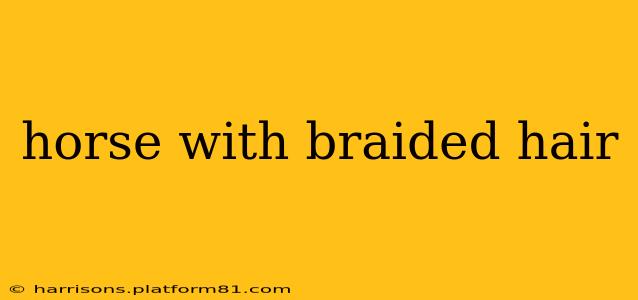Braiding a horse's mane and tail is more than just a cosmetic procedure; it's a time-honored tradition deeply rooted in equestrian culture and practicality. From show rings to casual trail rides, braided manes and tails are a common sight, showcasing both artistry and functionality. This comprehensive guide delves into the world of horse hair braiding, exploring its history, techniques, benefits, and common questions.
Why Do People Braid Horses' Hair?
This is a fundamental question that underpins the entire practice. The reasons are multifaceted and range from aesthetic appeal to practical considerations:
-
Show Ring Presentation: In many equestrian disciplines, braided manes and tails are mandatory for competition. Neatly braided hair presents a polished and professional appearance, crucial for scoring well in judged events. Different disciplines may have specific requirements for braid styles.
-
Mane and Tail Management: Braiding keeps long manes and tails organized and tangle-free, preventing discomfort for the horse and simplifying grooming. This is particularly beneficial for horses with thick, long hair that is prone to matting.
-
Protection from Injuries: Braids can offer a degree of protection during training or competition, minimizing the risk of the mane or tail getting caught on fences, equipment, or other horses.
-
Tradition and Aesthetics: For many, braiding is a cherished tradition passed down through generations of horse owners and riders. The intricate patterns and styles can be incredibly beautiful and add to the overall elegance of the horse.
What are the Different Types of Horse Braids?
There's a wide variety of horse braid styles, each with its own level of complexity and purpose. Some common types include:
-
Running Braids: These are simple, continuous braids that run along the length of the mane or tail. They're easy to learn and ideal for everyday use.
-
French Braids: More intricate than running braids, French braids incorporate strands from the surrounding hair, creating a more complex and secure braid.
-
Cornrows: Similar to French braids, cornrows are tightly braided close to the scalp, offering excellent control and preventing the mane from interfering with the horse's vision or movement.
-
Rope Braids: These braids are created by twisting sections of hair together rather than weaving them over and under. They are often used for tails.
-
Pull-Back Braids: These braids are often used for competition and involve pulling the mane back neatly, away from the face, often incorporating intricate patterns.
How Long Does it Take to Braid a Horse's Mane and Tail?
The time required to braid a horse's hair varies significantly depending on the horse's hair length, thickness, the complexity of the braid style, and the braider's experience. A simple running braid on a short mane might take 15-20 minutes, while a full set of elaborate show braids could take several hours.
What Tools Do You Need to Braid a Horse's Hair?
Proper tools are essential for successful horse hair braiding. You'll typically need:
-
Mane and Tail Comb: Essential for detangling and preparing the hair for braiding.
-
Rubber Bands: Secure the ends of the braids.
-
Braid Bands or Thread: Optional but can add extra security and a polished look.
-
Spray Bottle (Optional): Lightly misting the hair can help manage flyaways.
-
Scissors (Optional): For trimming stray hairs or creating a neater look.
Can I Learn to Braid My Horse's Hair Myself?
Absolutely! While it takes practice and patience, many horse owners successfully learn to braid their horses' hair. Numerous resources are available online, including videos and tutorials, that guide you through the process step-by-step. Starting with simpler braid styles is recommended before progressing to more complex techniques.
Is Braiding Harmful to Horses?
When done correctly, braiding is not harmful to horses. However, it's crucial to ensure the braids aren't too tight, which can cause discomfort or even injury. Regularly checking the braids for tightness and ensuring the horse shows no signs of discomfort is essential.
This guide provides a foundational understanding of horse hair braiding. Remember, patience and practice are key to mastering this skill. As you gain experience, you can experiment with different styles and techniques, creating beautiful and functional braids for your equine companion.
